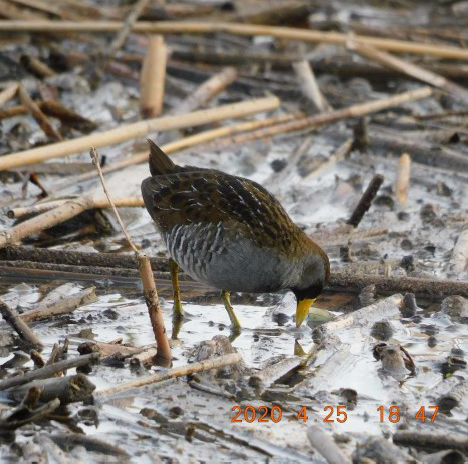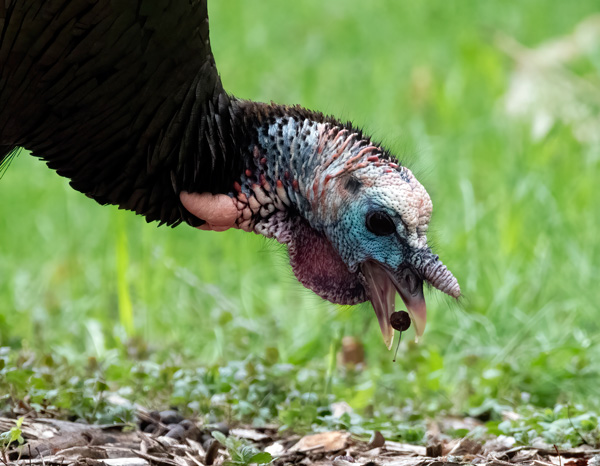|
March
2021
Contents
Monthly Meeting
Upcoming Field Trips
President's Message
Bird of the Month
Special Articles
Field Trip Reports
MARCH MEETING:
Wednesday, March 24th 7pm via Zoom. Tracy Aviary
together with the Utah Division of Wildlife Resources implement the North
American Breeding Bird Survey (BBS) in Utah every year with help from biologists
and birder volunteers across the state. Join us as we learn about the BBS, the
routes that are surveyed in Utah, and how you could potentially get involved.
Note from the board: Our sincere apologies for the issues we had with the
meeting last month. Thanks to Machelle for working through those issues quickly
and getting our meeting back on track, and thank you to all those that stuck
around with us for the great presentation that followed! We want to assure
everyone that we are taking steps to avoid having that happen in the future.
FIELD TRIPS:
MARCH 17TH
ST. PATTY'S
DAY
contest.
Do you have the "luck of the Irish?"
Do one or do all for a entry into our drawing.
1- Pick your field of clover
☘
(aka favorite
spot) find 4 species in one bird family.
2- Count as many species as you can in "17" minutes.
3- Find the most "lucky" RARE BIRD.
4- Find a 3 leaf
☘
of any 3 species
with green in their plumage.
Let's have some fun, get out of the house and press our luck!
Submit your findings on our Utah County Birders Facebook page or send a
email to nospam@suziholt.com. by the end of the day on March 17th. We will have a
drawing and draw 3 lucky winners. The more categories you enter the more
luck you have to win!
Stay posted to find out the lucky winners at our drawing out of a lucky hat
on March 18th at 10:00 am. We will post on Facebook and on the email. Feel
free to post pictures!!
HAPPY ST. PATRICK'S
DAY!!
|
President's Message -
March 2021
by Machelle Johnson
I don't have any travel stories to regale you with. No
exciting backyard birds. No crazy-quick trip to chase something rare. Just
my own musings, quite boring really. I was reading past newsletter articles,
which are awesome!, and realized that past presidents of our club had
fantastic article titles:
Robin Tuck: Robin's View
Dennis Shirley: Dennis' Droppings
Reed Stone: Reed's Ramblings
Alton Thygerson: Feather Talk
Merrill Webb: Merrill's Musings
Ned Hill: Ned's Notes
Keeli Marvel: Captain's Log
They wrote about all sorts of things relating to birds and birding. Lots of
birding, lots of traveling, lots of knowledge. Very enjoyable to read!
We don't have a formal challenge this year, but I'm trying to get out every
weekend for now. As the days get longer I like to leave early for work and
stop at places along my way, like East Bay or Provo Cemetery, or zip down to
ULSP on my way home from work. Soon spring migration will be here and we'll
have all sorts of birding to do. A couple of weekends ago I drove out to
Eureka and the west side of the lake looking for a Ferruginous Hawk, and found
one on the same pole that I saw one on last year at this time. A couple weeks
before that I saw 3 different owls in their favorite roosts in a cemetery. I
like knowing that there are some special places to go see those harder to find
birds, and that I have a good chance of seeing them at any given time. Most
of the time though, you have to be in the right place at the right time!
|
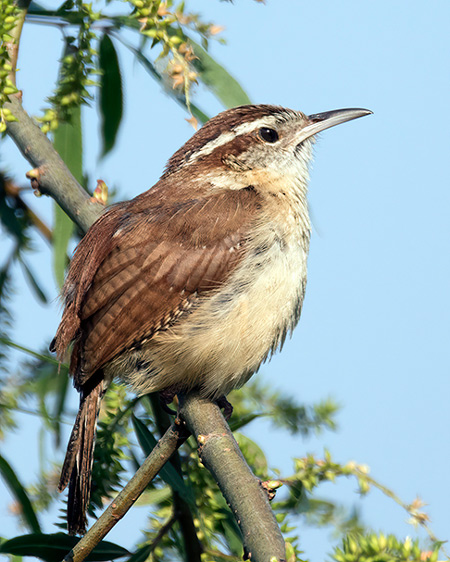
Carolina Wren by Kendall Brown |
|
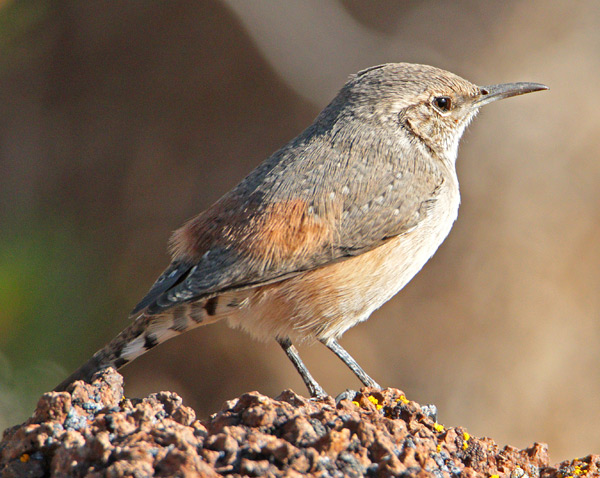
Rock Wren by Jim Bruce |
|
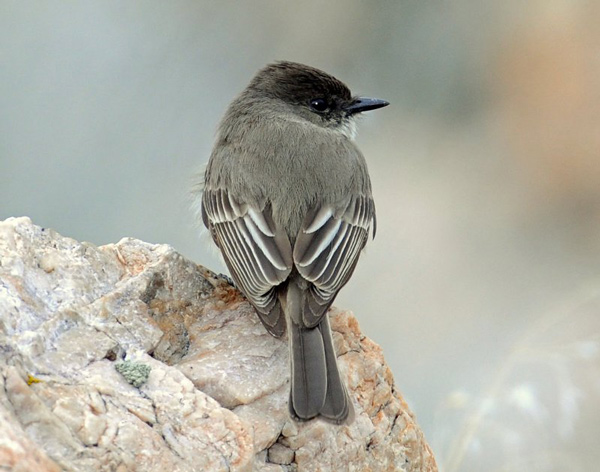
Eastern Phoebe by Paul Higgins |
Last month I wrote a bit about GISS, general impression of size and shape.
My favorite reference book is Pete Dunne's Essential Field Guide Companion.
In the chapter called 'A Guide to the Guide' he first tells us "Don't keep and
open mind" but then throughout the book gives us information on why we could
see a bird from the East coast in our backyard in Utah. 'Don't keep an open
mind' encourages us to narrow down to what we are likely to see in our
area. We want to be able to narrow down to Wren versus Flycatcher for
example. GISS helps us with that. From there we narrow down to Wrens we are
likely to see in our area. Then the details of field marks, plumage, habitat,
and actions come more into play. He calls this 'Identification Right Think'
Dunne says "Birds are creatures of habit and habitats. For example, you would
expect to find a Carolina Wren in a suburban, coastal community in New
Jersey. You would not expect a Rock Wren, a bird common to arid, rocky
slopes'. He gives all birds a VI number. VI stands for Vagrancy Index which
relates to the known vagrancy tendencies of a species or the possibility that
it may turn up where it doesn't belong. The VI number for a Carolina Wren is
1-2: Some slight tendency to wander, but such occurrences are regional,
extending not far beyond the established borders of the species' range. The
Rock Wren's number is 2: The species shows some modest pattern of vagrancy.
It is possible to encounter it outside it's normal range, but still not
likely, and you should consider other, more likely possibilities first.
I tend to be very 'narrow minded' with birding. It doesn't occur to me that I
might see an Eastern Phoebe in Lehi, Utah, like the one that was seen there
last year. I would have a hard time identifying that bird. I could narrow it
down to flycatcher, but would have a hard time getting to Eastern Phoebe.
Actually, maybe Flycatchers aren't a good example, it's hard to narrow down
those pesky birds that all look so similar! That is why I'm focusing this
year on GISS and Identification Right Think. I have my Pete Dunne book on my
Kindle app because I can't haul the actual book around, it's very large.
My goal this year to do be more open minded about birds, unless of course, I
shouldn't be open minded...
|
See you out there!
Machelle
,__,
(0,0)
/)_)
""
|
|
BIRD OF THE MONTH:
|
|
|
|
|
Sora
(Porzana carolina)
by Steve Van
Winkle
Porzana Carolina
sora or carolina rail
When is Less More? Last
April while birding adjacent to the Utah lake North Shore trail along the
shoreline, I had the good fortune of encountering this lone rail. And, deciding
not to rush ahead after taking a few photos in search of more daily species
entries (this is where less is more), I decided to take-a-sit and spend some
time observing this wonderful little marsh resident. I spent about 15 or so
minutes observing the rail maneuver through approximately 5+cm. of water amongst
the Typha latifolia, cattails, a very scant amount of invasive Phragmites
australis (less than 1%) and other aquatic vegetation in search of: larvae
stage of midges, sandflies, no-see-ums, mosquitoes, dragonflies and a few other
aquatic and semi-aquatic insects as well as fresh water mollusks (Dr. Gibbs,
1899) and dispersed plant seeds from the ever present and ubiquitous Red-root
flat sedge, Cyperus erytrorhizos, (Andrey Zharkikh, 2021).
|
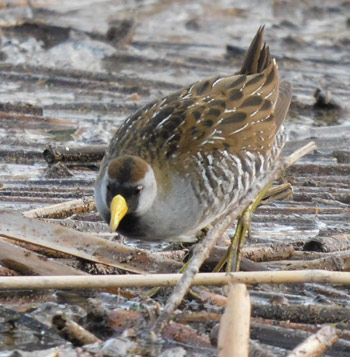
Both Sora photos
by Steve Van Winkle ©Steve Van
Winkle
|
This
particular rail, quite handsome adult male with its short stout yellow bill, an
extensive amount of black on the face, throat and breast, whitish lateral lines
on a rich brown background on the back and thicker vertical broken and staggered
bands of white and rich brown on the sides and belly, would dart to-and-fro from
the cover of the thick stands of catttails into a fairly open area to feed.
Apparently, not at all shy about my and Aussie’s presence sitting roughly 20 or
so feet from it. This individual did not “utter” any whinny or kerwee calls at
any time during our visit, neither did it flush “fluttering feebly along just
over the tops of the reeds and cattails, as described by James Audubon, 1840, in
his account of the Sora. And, despite its rather weak flight exhibition Forbush
(1914) attests to their remarkable abilities to migrate (perhaps, in a few
instances) nearly 2,500 miles during their journey to breeding grounds as far
north as the northern Canadian provinces to wintering grounds throughout
desirable habitat in Central America and the most northern regions of South
America.
On the 24th of
February 2021, I spent 30 or so minutes searching for last season’s nest of this
and perhaps other pairs along the shoreline and into the cattail stands
immediately offshore. And, I like so many other birders were unable to locate a
nest, that is a fairly shallow affair made from the thin blades of aquatic plant
material woven into a sturdy structure from cattails, reeds or sedges that
dominate the site concealed well beneath a canopy of sedge, grass, rush and in
this record cattail stems and blades. The clutch, often as many as 13 eggs, are
laid one/day and the chicks after being incubated by both male and female hatch
after about 19 days. These very precocious black downy young quite often leave
the nest within 3 days. It’s not rare but quite uncommon to discover the nest
with richly colored, “cinnamon buff” to “ivory yellow” and irregularly spotted
with “auburn” and “ecru drab” flecks, eggs due to the density of vegetation and
sheltering of the nest with a canopy of blades and stems (Lawrence Walkinshaw,
1940). Definitely, a most rewarding encounter of the Sora (Carolina) rail, and
singularly unique experience during my years of birding, despite having seen
this species in its preferred habitat in Oregon, Idaho and Nevada.
Interestingly, despite the fact that the Sora Rail is still hunted as game in at
least 31 states and estimated survival rate of chick to breeding adult
(approximately 30%), as detailed by Lawrence H. Walkinshaw in “Summer of Life of
the Sora Rail”, The Auk, Vol. 57 No. 2. the rail is currently listed as Least
Concerned by the A.O.U.. Its most obvious threat is development and coastal and
inland marsh degradation.
I very much
look forward to searching the shoreline again this coming season for this
wonderfully secretive and elusive species.
-
Lawrence
H. Walkinshaw, Summer Life of the Sora Rail, AUK, vol.5, no. 2, 1940
-
Arthur
Cleveland Bent, Life Histories of Familiar North American Birds
-
Aquatic
and Semiaquatic Vegetation of Utah Lake and its Bays, Great Basin Naturalist
Memoirs
-
Sora,
Scott M. Melvin and James P. Gibbs, Birds of the World, March 2020
Gratitude to these experienced amateur and professional ornithologists Whose
accurate field notes prove invaluable:
|
Special Articles:
|
|
|
New photos in
the Photo Gallery...
120 new browse-worthy photos
taken by
Kendall Brown
The photo on the
right shows the upper waddle lifting up as the
Wild Turkey plucks a
seed from the ground. Kendall Brown took this photo in Wisconsin on one of
his many trips around the world.
In Kruger National Park in South Africa, he took
a series of close-ups of a
Gray
Heron fishing and eating.
His posting of what looks to be a
Northern Shoveler doing a yoga routine illustrating the proper
concentration, deep breathing and balance of good yoga.
Closer to home Kendall got some photos of a young
Downy Woodpecker, with his speckled forehead and transient red
cap, poking his head out into the world possibly for the first time considering
the look of awe on his face.
He sent in photos from the Netherlands, England,
Costa Rica, Alaska, and Hawaii, as well as other places in the US.
Our Photo Gallery covers the birds of the US and
Canada, but sometimes it's easier to get photos of the rare birds at a place
where they are more common. Here's a link to the
"Latest
additions to the Photo Gallery."
Thanks to Kendall for sharing some of the
pictures he's collected during his many travels.
|
|
Good Birding! |
|
|
|
|
|
|
|
|
|
|
If you have had any interesting
field trips on your own this month,
feel free to write a report for the newsletter!
(Send it to:
ucbirders@utahbirds.org)
|
|
|




